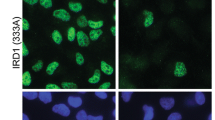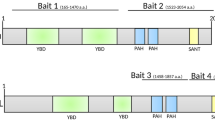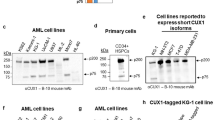Abstract
We isolated a 4301-bp cDNA from a human foetal brain cDNA library by high-throughput cDNA sequencing. It encodes a protein of 341 amino acids, which shows 69% identity with the human kinase CLIK1 (AAL99353), which was suggested to be the CLP-36 interacting kinase. Bioinformatics analysis suggests that the putative kinase may interact with PDZ and LIM domain proteins. Therefore the protein and its cDNA were named ’PDLIM1 interacting kinase 1 like’ (PDIK1L; nomenclature approved by the HUGO Gene Nomenclature Committee). Ensembl Genome Browser locatedPDIK1L to human chromosome 1p35.3. It spans about 13.7 kb and consists of four exons and three introns. Multiple-tissue cDNA panel PCR revealed that the gene is expressed widely in human tissues: liver, kidney, pancreas, spleen, thymus and prostate. The protein appears to be localized to the nucleus.
Similar content being viewed by others
References
Bashirova A. A., Markelov M. L., Shlykova T. V., Levshenkova E. V., Alibaeva R. A. and Frolova E. I. 1998 The humanRIL gene: mapping to human chromosome 5q31.1, genomic organization and alternative transcripts.Gene 210, 239–245.
Chen C. and Okayama H. 1987 High-efficiency transformation of mammalian cells by plasmid DNA.Mol. Cell. Biol. 7, 2745–2752.
Cho K. O., Hunt C. A. and Kennedy M. B. 1992 The rat brain postsynaptic density fraction contains a homolog of the Drosophila discs-large tumour suppressor protein.Neuron 9, 929–942.
Dawid I. B., Toyama R. and Taira M. 1995 LIM domain proteins.C. R. Acad. Sci. III 318, 295–306.
Dawid I. B., Breen J. J. and Toyama R. 1998 LIM domains: multiple roles as adapters and functional modifiers in protein interactions.Trends Genet. 14, 156–162.
Fanning A. S. and Anderson J. M. 1996 Protein-protein interactions: PDZ domain networks.Curr. Biol. 6, 1385–1388.
Guy P. M., Kenny D. A. and Gill G. N. 1999 The PDZ domain of the LIM protein enigma binds to beta-tropomyosin.Mol. Biol. Cell 10, 1973–1984.
Kotaka M., Ngai S. M., Garcia-Barcelo M., Tsui S. K., Fung K. P., Lee C. Y. and Waye M. M. 1999 Characterization of the human 36-kDa carboxyl terminal LIM domain protein (hCLIM1).J. Cell. Biochem. 72, 279–285.
Kotaka M., Kostin S., Ngai S., Chan K., Lau Y., Lee S. M., Li H., Ng E. K., Schaper J., Tsui S. K., Fung K., Lee C. and Waye M. M. 2000 Interaction of hCLIM1, an enigma family protein, with alpha-actinin 2.J. Cell. Biochem. 78, 558–565.
Kuroda S., Tokunaga C., Kiyohara Y., Higuchi O., Konishi H., Mizuno K., Gill G. N. and Kikkawa U. 1996 Protein-protein interaction of zinc finger LIM domains with protein kinase C.J. Biol. Chem. 271, 31029–31032.
Ponting C. P. and Phillips C. 1995 DHR domains in syntrophins, neuronal NO synthases and other intracellular proteins.Trends Biochem. Sci. 20, 102–103.
Sanchez-Garcia I. and Rabbitts T. H. 1994 The LIM domain: a new structural motif found in zinc-finger-like proteins.Trends Genet. 10, 315–320.
Taira M., Evrard J. L., Steinmetz A. and Dawid I. B. 1995 Classification of LIM proteins.Trends Genet. 11, 431–432.
Vallenius T. and Makela T. P. 2002 Clik1: a novel kinase targeted to actin stress fibers by the CLP-36 PDZ-LIM protein.J. Cell Sci. 115, 2067–2073.
Vallenius T., Luukko K. and Makela T. P. 2000 CLP-36 PDZ-LIM protein associates with nonmuscle alpha-actinin-1 and alpha-actinin-4.J. Biol. Chem. 275, 11100–11105.
Wang H., Harrison-Shostak D. C., Lemasters J. J. and Herman B. 1995 Cloning of a rat cDNA encoding a novel LIM domain protein with high homology to rat RIL.Gene 165, 267–271.
Xia H., Winokur S. T., Kuo W. L., Altherr M. R. and Bredt D. S. 1997 Actinin-associated LIM protein: identification of a domain interaction between PDZ and spectrin-like repeat motifs.J. Cell Biol. 139, 507–515.
Author information
Authors and Affiliations
Corresponding author
Rights and permissions
About this article
Cite this article
Guo, L., Ji, C., Gu, S. et al. Molecular cloning and characterization of a novel human kinase gene,PDIK1L . J Genet 82, 27–32 (2003). https://doi.org/10.1007/BF02715878
Received:
Revised:
Issue Date:
DOI: https://doi.org/10.1007/BF02715878




